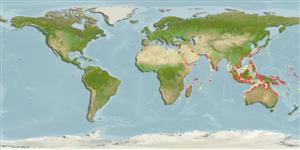Preferred temperature (Ref.
115969): 24.7 - 29, mean 28 (based on 596 cells).
Phylogenetic diversity index (Ref.
82804): PD
50 = 0.5078 [Uniqueness, from 0.5 = low to 2.0 = high].
Bayesian length-weight: a=0.01698 (0.01289 - 0.02237), b=2.96 (2.89 - 3.03), in cm Total Length, based on LWR estimates for this species (Ref.
93245).
Trophic level (Ref.
69278): 3.0 ±0.0 se; based on diet studies.
Resilience (Ref.
120179): High, minimum population doubling time less than 15 months (K=1.00-1.20).
Fishing Vulnerability (Ref.
59153): Low vulnerability (12 of 100).
